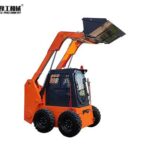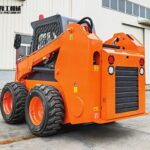Skid steer track loader is a compact, engine-powered machine designed for material handling, excavation, and terrain modification. It is characterized by its unique steering mechanism, where the machine turns by varying the speed and direction of its wheels or tracks on each side. What sets the track skid steer loader apart is its replacement of traditional wheels with continuous tracks, similar to those found on tanks or bulldozers. This design enhances traction, reduces ground pressure, and improves stability on soft or uneven surfaces. The skid steer track loader combines the compact body of a skid steer with the stability of rubber tracks, allowing it to operate where wheeled models would struggle. For leveling soil, lifting heavy pallets, clearing debris, or grading surfaces, the machine proves to be an indispensable asset.
Features and Characteristics
Compact Size and Maneuverability
Skid steer track loaders are built to navigate tight spaces without sacrificing power. Their small footprint allows them to operate in confined areas like indoor construction sites, narrow alleys, or densely planted landscapes.
Tracked Undercarriage for Enhanced Traction
The continuous tracks distribute the machine’s weight over a larger surface area, reducing ground pressure and preventing sinking in mud, sand, or snow. The tracks also provide superior grip on slopes, reducing the risk of slippage compared to wheeled skid steers.
Hydraulic Power for Versatile Attachments
Like all skid steers, track loaders rely on a hydraulic system to power their movements and attachments. A diesel engine drives hydraulic pumps that generate pressurized oil, which is then directed to motors controlling the tracks, lift arms, and auxiliary functions. This setup allows SSTls to accommodate a wide range of attachments, from buckets and forks to trenchers and hydraulic breakers, transforming them into multi-purpose tools.
Operator Safety and Comfort
Modern skid steer track loaders prioritize operator safety with enclosed cabs featuring. These cabs shield the operator from debris and extreme weather. Many models also include ergonomic seats, intuitive controls, and climate control systems to reduce fatigue during long shifts.
Structure and Components
The machine consists of a sturdy chassis, an engine, and the hydraulic system. The engine, typically a diesel unit, provides the power for both the machine’s movement and its hydraulic functions. The hydraulic system is the heart of the loader’s lifting and operational power. It consists of pumps, cylinders, and valves that control the movement of the lift arms and the attachment. The tracks and undercarriage system are what set this machine apart. The undercarriage includes the tracks, idlers, rollers, and sprockets that drive the movement. This system is robust and designed to withstand the rigors of heavy use on varied terrain. The operator’s cab provides a safe and comfortable environment for the user, with intuitive controls for all the machine’s functions.
Advantages of Using A Track Skid Steer Loader
Compared to wheeled skid steers and larger machinery, skid steer track loaders provide several advantages:
- Enhanced Traction: The tracked design allows them to work on mud, snow, and loose soil without sinking or slipping.
- Reduced Ground Pressure: Tracks distribute the machine’s weight evenly, minimizing damage to delicate surfaces like lawns or newly prepared soil.
- High Lifting Capacity: Despite their compact size, these machines can lift and transport heavy loads efficiently.
- All-Weather Versatility: Rain, snow, or heat does not limit performance, making them a reliable year-round solution.
- Attachment Flexibility: With one base machine, operators can perform dozens of tasks simply by changing attachments.
Applications of Skid Steer Track Loader
The adaptability of a track loader skid steer makes it useful across multiple industries. Some of the most common applications include:
- Construction: Digging, trenching, grading, and transporting building materials on rough terrain.
- Landscaping: Moving soil, rocks, mulch, and plants while shaping terrain for gardens, golf courses, and parks.
- Agriculture: Handling manure, feed, hay bales, and assisting with general farm maintenance.
- Forestry: Clearing brush, transporting logs, and mulching vegetation in wooded areas.
- Snow Removal: Equipped with a snow blower or blade, the loader efficiently clears roads, driveways, and parking lots.
- Demolition: Breaking concrete, removing debris, and loading waste for disposal.



